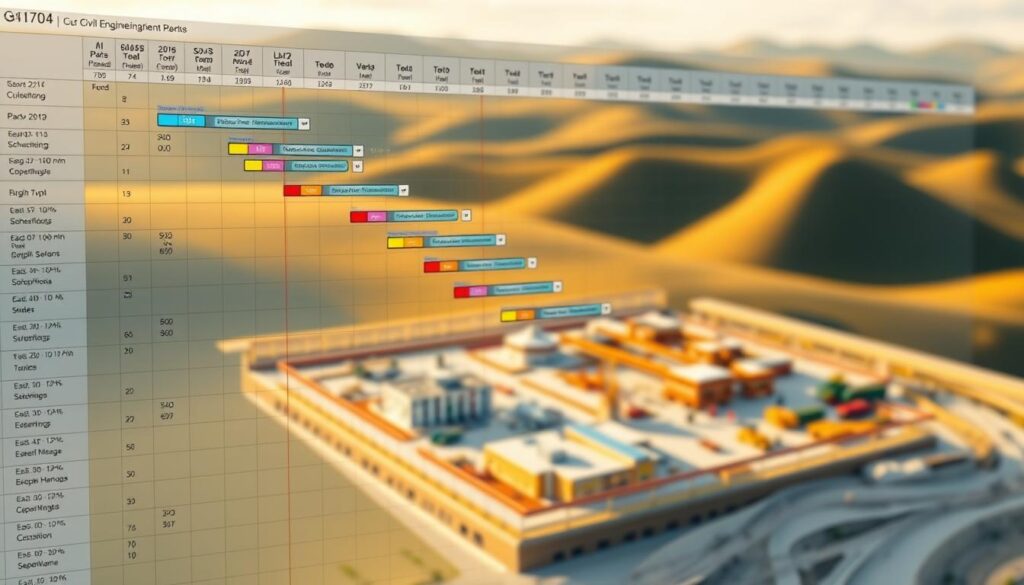Can a complex civil engineering project be successfully managed without a clear plan? Effective project management is crucial in civil engineering due to the complexity and scale of such projects. It involves coordinating various stakeholders, managing resources, and mitigating risks.
Understanding the basics of civil engineering project management is key to navigating the challenges that arise during the project lifecycle. From project planning to risk management, each stage is critical to ensuring the project’s success.
Key Takeaways
- Effective project planning is essential for civil engineering projects.
- Coordinating stakeholders and managing resources is crucial.
- Risk management is vital to mitigate potential issues.
- Understanding project management basics helps navigate challenges.
- A clear plan is necessary for successful project execution.
Understanding the Basics of Civil Engineering Projects
Understanding the basics of civil engineering projects is essential for any project manager looking to deliver results. Civil engineering projects are diverse and complex, involving the construction of infrastructure such as roads, bridges, and buildings.
Civil engineering projects require a comprehensive approach, from initial planning to final execution. This involves not only technical knowledge but also effective project management to ensure that projects are completed on time and within budget.
Definition and Types of Civil Engineering Projects
Civil engineering projects can be broadly categorized into several types, including transportation projects, water resource projects, and building construction projects. Each type has its unique challenges and requirements.
| Project Type | Description | Examples |
|---|---|---|
| Transportation | Involves the construction and maintenance of roads, highways, and bridges. | Highway construction, bridge repair |
| Water Resources | Focuses on the development and management of water resources. | Dams, water treatment plants |
| Building Construction | Involves the construction of buildings for various purposes. | Residential buildings, commercial complexes |
As noted by a civil engineering expert, “The key to successful project management lies in understanding the specific needs and challenges of each project type.”
“Effective project management in civil engineering requires a deep understanding of the project’s technical, financial, and environmental aspects.”
Importance of Project Management in Civil Engineering
Project management plays a vital role in civil engineering, ensuring that projects are executed efficiently and effectively. It involves planning, organizing, and controlling resources to achieve project objectives.
Effective project planning in civil engineering is critical for identifying potential risks and developing strategies to mitigate them. By applying construction project management tips and best practices, project managers can ensure that their projects are successful.
Initial Project Planning and Assessment
Initial project planning and assessment are vital components that determine the trajectory of civil engineering projects. This phase lays the groundwork for the entire project lifecycle, ensuring that it is executed efficiently and effectively.

Conducting Feasibility Studies
Conducting feasibility studies is a critical step in the initial project planning phase. It involves assessing the practicality of a project by evaluating its technical, financial, and operational viability. Feasibility studies help in identifying potential roadblocks and opportunities, allowing project managers to make informed decisions. For instance, a feasibility study might reveal that a proposed construction site is not suitable due to environmental concerns or that the project’s budget is not aligned with the expected outcomes.
During this phase, civil engineers and project managers work together to gather data, conduct site analyses, and assess the project’s potential impact on the environment and local communities. This information is crucial for determining whether to proceed with the project, modify it, or abandon it altogether.
Identifying Project Scope
Identifying the project scope is another crucial aspect of initial project planning. It involves defining what needs to be done, the project’s objectives, and the deliverables. A well-defined project scope helps in preventing scope creep, which can lead to delays and cost overruns. By clearly outlining the project’s boundaries, project managers can ensure that all stakeholders are on the same page and that the project stays focused on its core objectives.
- Define project objectives and deliverables
- Identify key stakeholders and their roles
- Establish the project’s technical requirements
- Determine the project’s timeline and milestones
Setting Objectives and Deliverables
Setting clear objectives and deliverables is essential for the successful execution of civil engineering projects. This involves establishing specific, measurable, achievable, relevant, and time-bound (SMART) goals that align with the project’s overall vision. Effective project scheduling for civil engineers is critical during this phase, as it ensures that the project is completed on time and within budget.
Moreover, project budgeting in civil engineering plays a vital role in setting objectives and deliverables. By establishing a realistic budget, project managers can allocate resources effectively, prioritize tasks, and ensure that the project is financially viable. This helps in minimizing financial risks and ensuring that the project meets its intended outcomes.
“A budget is not just a numbers game; it’s about making strategic decisions that drive project success.” –
By conducting thorough feasibility studies, identifying the project scope, and setting clear objectives and deliverables, civil engineers and project managers can ensure that their projects are well-planned, executed efficiently, and meet the stakeholders’ expectations.
Forming Your Project Team
A well-defined project team is the backbone of any successful civil engineering endeavor. The team’s composition and dynamics play a crucial role in determining the project’s outcome. Effective civil engineering project management hinges on the ability to assemble a team that is both competent and collaborative.
Roles and Responsibilities in a Civil Engineering Team
In a civil engineering project, each team member has distinct roles and responsibilities. These roles are crucial for the project’s success and include:
- Project Manager: Oversees the entire project, ensuring it is completed on time and within budget.
- Design Engineers: Responsible for the design aspects of the project, ensuring compliance with engineering standards.
- Site Engineers: Manage the construction site, overseeing the practical implementation of the project design.
- Consultants: Provide specialized advice on various aspects of the project, such as environmental impact or structural integrity.
Clear definition of these roles and their responsibilities is essential for avoiding confusion and ensuring that all aspects of the project are covered. Effective project communication strategies are vital in this regard, facilitating seamless interaction among team members.
Selecting Qualified Engineers and Consultants
The selection of qualified engineers and consultants is a critical step in forming a project team. This involves evaluating potential team members based on their experience, expertise, and past performance. A competent team not only enhances the project’s chances of success but also contributes to effective project management.
| Criteria | Description | Importance Level |
|---|---|---|
| Experience | Relevant experience in civil engineering projects | High |
| Expertise | Specialized knowledge in specific areas of civil engineering | High |
| Past Performance | Track record of successfully managing or contributing to similar projects | Medium |
By carefully selecting team members based on these criteria, project managers can build a strong foundation for their project’s success. Moreover, fostering a collaborative environment and implementing effective project communication strategies will further enhance the team’s performance and overall project outcome.
Developing a Project Timeline
Developing a project timeline is a crucial step in managing a civil engineering project from start to finish. A well-structured timeline helps in tracking progress, identifying potential delays, and ensuring that the project stays on schedule. By breaking down the project into manageable tasks, civil engineers can create a realistic timeline that accounts for all necessary steps.

Creating a Work Breakdown Structure
A Work Breakdown Structure (WBS) is a fundamental tool in project management that involves dividing the project into smaller, more manageable components. This hierarchical decomposition helps in organizing tasks, allocating resources, and estimating costs more accurately. By creating a WBS, project managers can ensure that all aspects of the project are covered and that nothing is overlooked.
To create an effective WBS, start by identifying the major deliverables of the project. Then, break down these deliverables into smaller tasks until you reach a level where each task is clearly defined and can be easily managed. This process not only aids in project scheduling but also enhances team collaboration by clearly defining roles and responsibilities.
Establishing Milestones and Deadlines
Once the WBS is in place, the next step is to establish milestones and deadlines. Milestones are significant events or accomplishments that mark the progress of the project. By setting clear milestones, project managers can track the project’s progress and ensure that it is moving in the right direction.
Deadlines are critical in maintaining the project schedule. By assigning realistic deadlines to each task, project managers can create a sense of urgency and focus among team members. It’s essential to ensure that these deadlines are achievable and take into account potential risks and uncertainties.
Effective project scheduling for civil engineers involves not just creating a timeline but also continuously monitoring and updating it. By using construction project management tips and tools, such as Gantt charts and project management software, civil engineers can stay on top of their projects and make necessary adjustments as the project progresses.
Budgeting for a Civil Engineering Project
Effective budgeting is the backbone of any successful civil engineering project, ensuring that resources are utilized efficiently from start to finish. A well-crafted budget helps project managers make informed decisions, avoid cost overruns, and deliver projects on time.
Estimating Costs Accurately
Accurate cost estimation is a critical component of project budgeting in civil engineering. It involves assessing various costs, including materials, labor, equipment, and overheads. Utilizing historical data and industry benchmarks can significantly enhance the accuracy of cost estimates. Additionally, employing advanced cost estimation techniques and tools can help project managers account for potential risks and uncertainties.
To estimate costs effectively, project managers should consider the following:
- Breaking down the project into smaller, manageable tasks to estimate costs at a granular level.
- Consulting with experts and stakeholders to gather insights and validate estimates.
- Using cost estimation software to streamline the process and improve accuracy.
Allocating Resources Wisely
Once costs are estimated, the next step is to allocate resources wisely. This involves assigning the right resources to the right tasks at the right time. Efficient resource allocation not only helps in staying within budget but also ensures that the project progresses smoothly. Project managers must balance the allocation of resources such as labor, materials, and equipment to maximize productivity and minimize waste.
Effective resource allocation strategies include:
- Prioritizing tasks based on their criticality and dependencies.
- Utilizing resource management tools to track availability and utilization.
- Adjusting allocations as needed to respond to project changes or unforeseen circumstances.
By focusing on accurate cost estimation and wise resource allocation, civil engineering projects can be managed more effectively, ensuring they are completed within budget and on schedule.
Risk Management Strategies
The success of civil engineering projects heavily relies on the implementation of robust risk management techniques. Effective risk management involves a proactive approach to identifying, assessing, and mitigating risks that could impact the project timeline, budget, or quality.

Identifying Potential Risks
Identifying potential risks is the first step in project risk management techniques. This involves analyzing the project scope, stakeholders, and external factors to determine potential risks. Common risks in civil engineering projects include environmental factors, design complexities, and supply chain disruptions.
| Risk Category | Description | Potential Impact |
|---|---|---|
| Environmental | Weather conditions, natural disasters | Delays, damage to infrastructure |
| Design | Complexities, errors in design | Cost overruns, rework |
| Supply Chain | Material shortages, vendor insolvency | Delays, cost escalation |
Developing Mitigation Plans
Once potential risks are identified, the next step is to develop mitigation plans. This involves assessing the likelihood and potential impact of each risk and devising strategies to minimize or eliminate them. Effective mitigation plans are crucial for civil engineering project management, ensuring that projects are delivered on time, within budget, and to the required quality standards.
- Develop contingency plans for high-risk events
- Implement quality control measures to minimize design and construction errors
- Establish strong relationships with multiple suppliers to mitigate supply chain risks
By adopting a proactive approach to risk management, civil engineering project managers can significantly reduce the likelihood of project delays, cost overruns, and other adverse outcomes. This not only ensures the success of the project but also enhances the reputation of the project team and stakeholders.
Securing Necessary Permits and Approvals
Before breaking ground, civil engineers must navigate the complex process of securing permits and approvals. This critical step ensures compliance with local regulations, avoiding potential delays and legal issues that can arise from non-compliance.
Understanding Local Regulations
Local regulations play a crucial role in determining the requirements for permits and approvals. These regulations can vary significantly from one jurisdiction to another, making it essential for project managers to understand the specific laws governing their project location.
Key aspects of local regulations include:
- Zoning laws that dictate land use
- Environmental regulations to protect natural resources
- Building codes that ensure structural integrity and safety
By familiarizing themselves with these regulations, project managers can streamline the permit approval process, reducing the risk of costly delays or fines.
Navigating the Permit Approval Process
Navigating the permit approval process requires careful planning and preparation. It involves submitting detailed applications, supporting documents, and sometimes, attending public hearings.
The steps involved in the permit approval process typically include:
- Preparing and submitting permit applications
- Providing supporting documentation, such as design plans and environmental impact assessments
- Addressing any concerns or objections raised by regulatory authorities
| Permit Type | Description | Typical Processing Time |
|---|---|---|
| Building Permit | Required for construction, renovation, or demolition projects | 2-4 weeks |
| Environmental Permit | Necessary for projects that may impact the environment | 4-6 months |
| Zoning Permit | Ensures compliance with local zoning laws | 1-3 months |
By understanding the permit approval process and preparing accordingly, civil engineers can minimize delays and ensure that their projects remain on schedule.
Effective construction project management tips often emphasize the importance of securing necessary permits and approvals. By doing so, project managers can avoid legal complications and ensure a smoother project execution.
Project Design and Engineering Phase
The project design and engineering phase is a pivotal stage in civil engineering projects, requiring meticulous planning and collaboration. During this phase, the project’s design is developed in detail, and it is crucial that all stakeholders are aligned with the project’s objectives and requirements.
Effective project communication strategies play a vital role in ensuring that the design meets the project’s needs and is executed correctly. Regular updates and feedback loops among team members facilitate a smooth design process.
Collaborating with Architects and Designers
Collaboration with architects and designers is essential to develop a comprehensive design that meets both aesthetic and functional requirements. This involves:
- Regular meetings to discuss design progress and challenges
- Utilizing collaborative design tools to facilitate real-time feedback
- Ensuring that all design elements comply with relevant building codes and standards

Ensuring Design Compliance with Standards
Ensuring that the design complies with relevant standards and regulations is critical. This includes:
- Reviewing and adhering to local building codes and zoning regulations
- Conducting regular design reviews to ensure compliance with project specifications
- Engaging with regulatory bodies to obtain necessary approvals
Project scheduling for civil engineers is also a key aspect of this phase, as it involves creating a detailed timeline that accommodates design development, review, and approval processes.
| Design Element | Compliance Requirement | Responsible Party |
|---|---|---|
| Structural Integrity | Building Codes | Structural Engineer |
| Architectural Design | Zoning Regulations | Architect |
| Environmental Impact | Environmental Regulations | Environmental Consultant |
By focusing on collaboration, compliance, and effective project scheduling, civil engineers can ensure that the project design and engineering phase is executed efficiently, setting the stage for successful project delivery.
Procurement and Contract Management
Effective procurement and contract management are crucial for the success of civil engineering projects. These processes ensure that goods and services are acquired in a timely manner, within budget, and to the required quality standards.
Selecting Vendors and Suppliers
The selection of vendors and suppliers is a critical aspect of procurement in civil engineering projects. It involves evaluating potential candidates based on their ability to meet project requirements, their reputation, and their pricing. A thorough evaluation process helps in identifying reliable vendors who can deliver quality goods and services on time. This step is essential for maintaining project timelines and budgets.
To select the right vendors, project managers should develop clear evaluation criteria, including factors such as past performance, technical capability, and financial stability. Conducting thorough background checks and seeking references can also provide valuable insights into a vendor’s reliability and competence.
Managing Contracts Effectively
Managing contracts effectively is vital to ensure that the terms and conditions agreed upon with vendors and suppliers are met. This involves monitoring contract performance, managing changes to the contract, and resolving disputes. Effective contract management helps in minimizing risks and ensuring that project deliverables are met.
To manage contracts effectively, project managers should maintain open lines of communication with vendors, conduct regular progress meetings, and document all interactions. Utilizing contract management software can also streamline the process, making it easier to track compliance and performance.
By focusing on procurement and contract management, civil engineering projects can better achieve their objectives in terms of time, budget, and quality. Implementing construction project management tips such as thorough vendor selection and effective contract management can significantly enhance project outcomes.
Implementing Construction Practices
The success of a civil engineering project heavily relies on the implementation of effective construction practices. This includes adopting best practices for site management and ensuring safety on the job site.
Best Practices for Site Management
Effective site management is critical for the smooth execution of civil engineering projects. This involves:
- Coordinating with contractors and subcontractors
- Managing resources efficiently
- Maintaining a clean and organized site
By implementing these practices, project managers can minimize delays and ensure that the project stays within budget.

Ensuring Safety on the Job Site
Safety is paramount on any construction site. Ensuring safety involves:
- Conducting regular safety audits
- Training personnel on safety protocols
- Implementing safety measures such as personal protective equipment (PPE)
By prioritizing safety, project managers can reduce the risk of accidents and ensure a safe working environment.
| Safety Measure | Description | Benefit |
|---|---|---|
| Regular Safety Audits | Identifying potential hazards before they become incidents | Reduces risk of accidents |
| Personnel Training | Ensuring all personnel are aware of safety protocols | Enhances safety culture |
| Personal Protective Equipment (PPE) | Providing necessary gear to protect workers | Minimizes injury risk |
Effective construction practices, including site management and safety protocols, are essential for the successful completion of civil engineering projects. By adopting these practices, project managers can ensure their projects are completed on time, within budget, and to the required quality standards.
Monitoring Progress and Performance
The key to successful project management lies in the ability to monitor and adjust project progress and performance. In civil engineering projects, this involves a combination of using the right tools and tracking the right metrics.
Utilizing Project Management Tools is essential for tracking the progress of a project. These tools can range from simple spreadsheets to sophisticated software that can handle complex project scheduling, budgeting, and resource allocation. By leveraging these tools, project managers can get a real-time view of their project’s status, identify potential issues early, and make informed decisions.
Utilizing Project Management Tools
Project management tools help in organizing tasks, allocating resources, and setting deadlines. They enable project managers to monitor the progress of various tasks and activities, ensuring that the project stays on track. Some of the key features of project management tools include Gantt charts, resource allocation modules, and collaboration tools.
Effective use of these tools can significantly enhance the project manager’s ability to monitor and control the project. For instance, Gantt charts provide a visual representation of the project schedule, making it easier to identify dependencies and potential bottlenecks.
Key Performance Indicators (KPIs) to Track
To effectively monitor project performance, it’s crucial to identify and track the right KPIs. These indicators provide insights into various aspects of the project, such as its financial health, schedule adherence, and quality of work. Common KPIs in civil engineering projects include cost variance, schedule performance index, and defect density.
Tracking KPIs allows project managers to assess the project’s performance against its objectives and make necessary adjustments. For example, if the cost variance indicates that the project is over budget, the project manager can investigate the causes and implement corrective measures.
By combining the right project management tools with relevant KPIs, civil engineering project managers can ensure that their projects are executed efficiently and effectively, meeting their intended objectives within the planned timeframe and budget.
Communication Strategies for Project Success
Communication is key to the successful management of civil engineering projects, influencing both team collaboration and stakeholder satisfaction. Effective project communication strategies are essential for keeping all parties informed and aligned with project objectives.

Keeping Stakeholders Informed
Keeping stakeholders informed is critical to maintaining trust and ensuring that project decisions are supported. This involves regular updates on project progress, timelines, and any changes that may impact the project’s scope or budget. Transparent communication helps in managing expectations and reducing the risk of misunderstandings.
To keep stakeholders informed, project managers can use various communication tools and techniques, such as:
- Regular project meetings and status updates
- Detailed project reports and dashboards
- Email notifications and alerts
Facilitating Team Communication
Facilitating open and effective communication within the project team is equally important. This involves creating an environment where team members feel comfortable sharing their ideas, concerns, and feedback. Collaboration tools and regular team meetings can significantly enhance team communication.
Some effective strategies for facilitating team communication include:
| Strategy | Description | Benefits |
|---|---|---|
| Regular Team Meetings | Weekly or bi-weekly meetings to discuss project progress and address issues. | Enhances collaboration, resolves issues promptly. |
| Collaboration Tools | Utilizing digital tools for file sharing, communication, and project tracking. | Improves information accessibility, reduces misunderstandings. |
By implementing these construction project management tips, project managers can significantly improve both stakeholder satisfaction and team collaboration, ultimately contributing to the project’s success.
Conducting Quality Control and Assurance
Quality control and assurance are vital components of any civil engineering project. Ensuring that all aspects of the project meet the required standards is crucial for its overall success.
Importance of Quality Checks
Quality checks are essential to identify any defects or areas that require improvement. Regular inspections and tests help in maintaining the quality of the project. By doing so, project managers can minimize the risk of costly rework and ensure compliance with regulatory standards.
Key aspects of quality checks include:
- Regular inspections of the construction site
- Testing of materials and equipment
- Review of design documents and plans
Implementing Quality Improvement Strategies
Implementing quality improvement strategies is a proactive approach to enhancing the overall quality of the project. This involves analyzing data from quality checks, identifying trends, and making necessary adjustments. Effective quality improvement strategies can lead to increased efficiency, reduced costs, and improved customer satisfaction.
For instance, adopting project risk management techniques can help in identifying potential quality issues early on, allowing for timely mitigation. Similarly, effective project budgeting in civil engineering ensures that adequate resources are allocated for quality control measures.
| Quality Control Measure | Description | Benefits |
|---|---|---|
| Regular Site Inspections | Frequent visits to the construction site to monitor progress and identify potential issues. | Early detection of defects, improved compliance with safety standards |
| Material Testing | Testing of materials to ensure they meet the required specifications. | Ensures durability and quality of the structure, reduces the risk of material failure |
| Design Review | Thorough review of design documents to ensure accuracy and compliance with standards. | Reduces errors, ensures compliance with regulatory requirements |
Project Completion and Handover Process
The project completion and handover process is a vital phase in the lifecycle of a civil engineering project. It involves a series of activities that ensure the project is completed to the required standards and handed over to the client or stakeholders. Effective management of this phase is crucial for the overall success of the project.
Final Inspections and Approvals
Conducting final inspections is a critical step in the project completion process. It involves checking that all work has been completed according to the specifications and standards outlined in the project plan. This step is essential for identifying any defects or omissions that need to be addressed before the project can be considered complete.
As part of the final inspections, project managers should:
- Review the project scope and specifications to ensure compliance.
- Conduct a thorough inspection of the site or facility.
- Document any findings, including defects or areas for improvement.
Obtaining necessary approvals is also a key aspect of this phase. This involves securing formal acceptance from the client or relevant authorities that the project has been completed satisfactorily. The process typically includes:
| Approval Stage | Description | Responsible Party |
|---|---|---|
| Initial Review | Preliminary review of project completion. | Project Manager |
| Client Inspection | Client reviews the project for acceptance. | Client |
| Final Approval | Formal approval and acceptance of the project. | Client/Project Manager |
Preparing Project Documentation
Preparing comprehensive project documentation is essential for the handover process. This documentation serves as a record of the project’s history, including its planning, execution, and completion. It is crucial for future reference, maintenance, and potential expansions or modifications.
Key documents typically included in the project handover documentation are:
- As-built drawings and specifications.
- Operation and maintenance manuals.
- Records of materials and equipment used.
- Warranty and guarantee documents.
As emphasized by industry experts, “Proper documentation is key to a smooth handover and ensures that the client has all necessary information to operate and maintain the facility effectively.” This highlights the importance of meticulous documentation in the project completion phase.

By focusing on these aspects, project managers can ensure a successful project completion and handover, marking the culmination of their efforts in managing the project from start to finish. Effective project scheduling for civil engineers plays a significant role in this final phase, ensuring that all necessary steps are taken and completed on time.
Lessons Learned and Project Evaluation
Effective civil engineering project management involves more than just completing a project on time and within budget. It requires a thorough evaluation of the project’s outcomes and a documentation of the lessons learned throughout the process. By analyzing project outcomes, project managers can identify areas for improvement and develop strategies to address these challenges in future projects.
Analyzing Project Successes and Challenges
A comprehensive project evaluation should assess both the successes and challenges encountered during the project. This involves evaluating the effectiveness of project communication strategies, identifying any issues that arose, and determining how they were addressed. By understanding what worked well and what didn’t, project managers can refine their approaches to improve future project outcomes.
Gathering Feedback for Continuous Improvement
Gathering feedback from team members, stakeholders, and clients is a crucial step in the project evaluation process. This feedback can provide valuable insights into the strengths and weaknesses of the project management approach used. By incorporating this feedback into future projects, civil engineering project managers can continuously improve their practices, enhancing their overall project management capabilities and delivering better results for clients.

Pingback: Civil Engineering Board Exam: Essential Practice Questions
Pingback: Engineering Capstone Project: A Step-by-Step Guide - worldcivilsociety.com
Pingback: Master Infrastructure Project Management for Success
Pingback: Hydrological Engineering: Unlocking the Secrets of Water
Pingback: Integrated Infrastructure Development: Building a Better Future
Pingback: Integrated Infrastructure Development
Pingback: Mastering Stakeholder Engagement in the Engineering Field
Pingback: Parking Lot Design Engineering: Maximize Efficiency and Safety - worldcivilsociety.com
Pingback: Optimizing Urban Water Infrastructure: Essential Engineering Insights - worldcivilsociety.com
Pingback: Optimize Water Infrastructure Asset Management
Pingback: Water Engineering Project Case Study: A Detailed Guide
Pingback: Become a Successful Project Manager: Key Responsibilities - worldcivilsociety.com
Pingback: Effective Project Management: Tackling Key Tasks for Success
Pingback: Mastering the Role of a Project Manager: Essential Tips